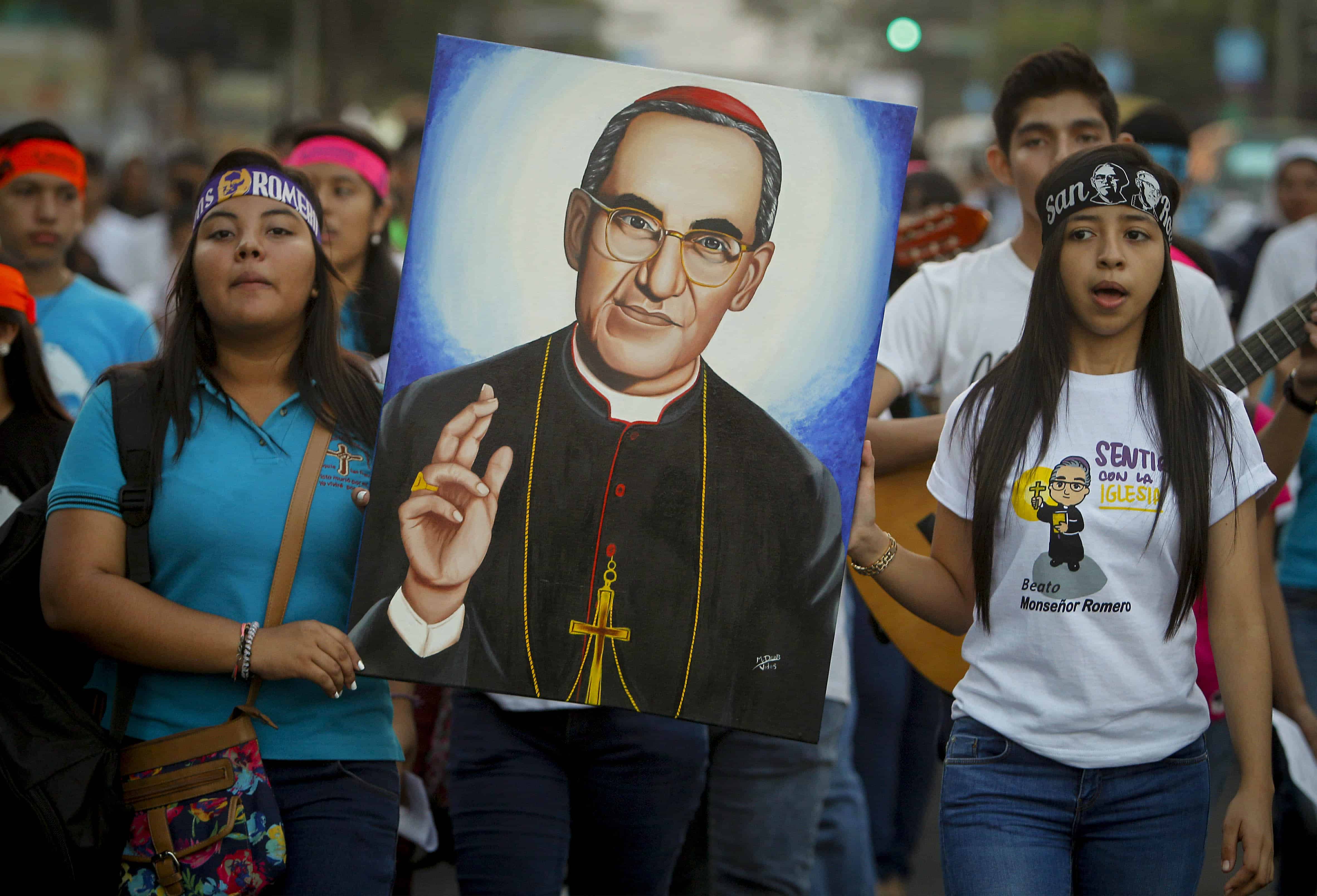Haga clic aquí para español.
Monseñor Óscar Romero was shot on Monday, March 24, as he said Mass in the chapel at Divina Providencia Hospital, where he resided. He preferred simple rooms to something more episcopal. His funeral took place on Palm Sunday, 1980, six days later. Though the gunshot made Romero a martyr, it was his funeral that set the tone for the long battle leading to his soon-coming canonization.
Watch the video of Romero’s funeral: you’ll see why. The plaza that sits in front of the San Salvador cathedral is packed with people, palm branches in hand for the beginning of Holy Week. The funeral cortège exits the cathedral. The gunfire begins. People run for cover. Some pull out weapons in self-defense. The dead and wounded are later carried off the streets.
People weren’t there to protest. They were there after their archbishop was shot by paramilitaries who, with the army and U.S.-funded firepower, were preparing to face off with leftist guerrillas in a ten-year civil war.
Monseñor Romero’s funeral made clear that even if he claimed to be giving voice to the voiceless, that he, his legacy, and his Church would be interpreted as political actors — and as fair targets.
Regardless of the man’s virtue or holiness, Romero being declared a martyr or a saint would be a political matter. And it still is.
*****
Romero’s October 14 canonization took place at the Vatican. The setting was traditional, but a lamentable one for Salvadoran Catholics, many of whom cannot afford to travel to Rome to attend the ceremony. But maybe it’s better this way.
El Salvador has still not reconciled over the civil war. The far-right in the country is unrepentant for its involvement in Romero’s death, and his image has been sanitized in recent years to make sainthood more acceptable.
Politics in the small country are not the same as in the 1970s and ‘80s, but some of the same political radicalization is alive and well. You can still read a headline like, “ARENA ratifies its devotion to d’Aubuisson days out from the canonization of Romero.” ARENA, the Nationalist Republican Alliance, is the right-wing party founded by d’Aubuisson. And d’Aubuisson is generally considered to be the man who orchestrated Romero’s murder.
The political descendants of d’Aubuisson still unashamedly embrace the political ideology that justified Romero’s murder, and one man involved in the crime still lives in impunity.
That has direct implications for considering Romero’s sanctity. From the end of the civil war until 2009, El Salvador was ruled by the ARENA party. As Carlos Dada explains, “the official postulant of the cause for Romero’s sainthood revealed that three Salvadoran ambassadors to the Vatican — he refused to name them — had actively lobbied against the canonization process, arguing that Romero was still a politically divisive figure in El Salvador and that his elevation to the altars could be manipulated by the leftist groups.”
That is, if Romero’s sainthood seems to be coming rather late, it’s for political reasons — no oversimplification.
*****
His personal holiness is not really at issue in his canonization, but instead his impact on the Church’s image in his country. The main question has been whether he politicized the Church’s role in public life, whether he took sides with Marxists and compromised the faith in doing so.
First of all, most of his actual work lacks any indication of radical politics.
Romero was unquestionably orthodox and loyal. His diary, a catalogue of daily activities more than his spiritual life, is peppered with beautiful reflections on what fidelity to Rome meant for him as archbishop. For anyone who reads it, there can be no doubt that he was deeply committed to living faithful to the pope, even when reprimanded by him.
Though often identified with liberation theology, he was not on the cutting edge of theological reflection. In the years before being selected as archbishop, he struggled to accept what Vatican II meant for the Church in El Salvador, and he struggled to accept those comfortable with the rapid changes in Church life. He was instrumental in kicking the Jesuits out of the interdiocesan seminary in the early 1970s for that reason.
And frankly, he was not on the cutting edge of pastoral work either, even by Central American standards. He read out the news from the pulpit on Sundays when basic news was censored by the government; he was concerned with the distortion of the truth. He supported the religious sisters and clergy in his diocese. But he wasn’t the brains behind daring pastoral experiments, like Rutilio Grande, SJ’s consciousness-raising work in Aguilares.
His image, however, is not so simple.
Romero has been interpreted broadly as having something to do with leftist politics. It’s true, but the claim requires some nuance.
As archbishop he freely chose to stand by his people through atrocious violence, and gained the admiration of both Catholics and non-Catholics. In his own words, “If there’s a conflict between the government and the Church, it isn’t because the Church is opposed to the government, it’s because there’s already a conflict between the government and the people, and the Church defends the people.”
He stopped attending any government functions shortly after becoming archbishop because Rutilio Grande’s 1977 murder was never investigated. In contrast, he continued meeting and dialoguing with non-Church people. Church buildings were often seized by groups trying to have their demands heard, and Romero often attempted to mediate personally. He condemned the violence of leftist groups, but the ripples of interrupting the status quo with an increasingly homicidal government were bigger.
To the government, he was the same as the communists who took cover in the main churches of San Salvador from time to time. Both communists and Catholics were tortured and killed before and after Romero’s murder. They were equated in the eyes of the military and the paramilitary groups.
If radicals got behind Romero, it’s because his pastoral care didn’t stop at those who were unquestionably orthodox. In the decades since his death, that has not been forgotten.
One of my favorite examples of Romero’s less-than-tidy image: according to Élmer Menjívar, there are those who call him “the patron saint of atheists,” a paradoxical title if there ever was one.
Catholic supporters, argues Dada, “have tried to strip his legacy of any political controversy.” Contemporary polemics around Romero’s legacy attempt to paint an orthodox and meek bishop, which is not an unfaithful depiction. “Romero, they argue, acted strictly based on the Gospels. He was killed because of his faith,” Dada explains.
That purified image comes at a price: the truth. Romero did have controversial politics and there have been real disagreements since his death about what it means for a prelate to take sides in political violence.
If Romero is cast as a holy man with no politics, it may also be an attempt to exorcise the historical opposition within his own bishops’ conference. In his diary, Romero relates how painful it was for him when his brother bishops opposed his work. When John Paul II visited El Salvador in 1996, Bishop René Revelo told him, “Romero is the one responsible for the 70,000 dead in this country.” In life and in death, Romero was painted as the culprit.
The attempt to wash out any political stains from Romero’s legacy in order for him to be El Salvador’s first saint has been “cynicism, mockery, hypocrisy, opportunism, pragmatism, marketing,” writes Menjívar.
I’m not inclined to disagree with Menjívar’s assessment. There is something to be gained in downplaying the controversy that swirled around him in his own time and since. But a substantial part of Romero’s sainthood might lie precisely in dialoguing with and defending non-Church people, in exercising his power as archbishop on behalf of more than just Catholics — in not drawing a neat line so other folks would take a bullet. He was the archbishop for everyone, including those outside the fold.
Yes, perhaps it is better for the canonization to be in Rome, where the public presence of those who once opposed him might not further ingrain the belief that you can celebrate Salvadoran sainthood and want Romero dead at the same time.
But when Romero is canonized, it will also seal an important part of Romero’s legacy — his unwillingness to entertain oppressors and his openness to dialogue with revolutionaries. I’m not sure his image can bring reconciliation in El Salvador, not if we’re honest about his work, his legacy, and the country today.
*****
Once canonized, the meek bishop and shrewd political actor will be revered by the universal Catholic Church. He will be remembered fondly next March on his feast day, and not for the first time. He will also be despised: he represents the Church taking sides for the sake of the poor and vulnerable, regardless of their politics.
Like Romero’s funeral and canonization, modern holiness — in front of cameras and recorded for posterity — is not without a struggle. It’s bloody, and clearly not everyone is on the same page. It should be a call to conversion, but it may better be described as a sign of contradiction, revealing the hearts of many.


